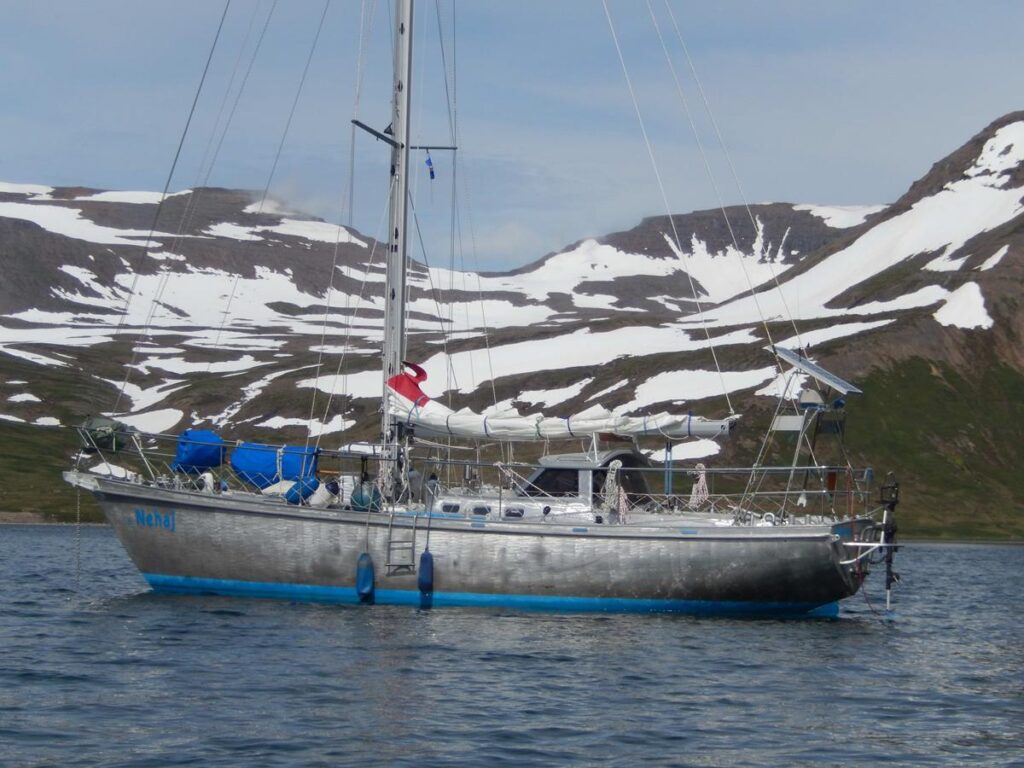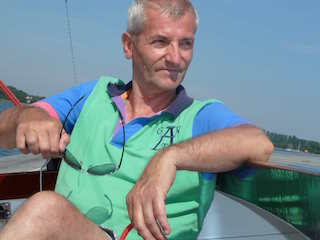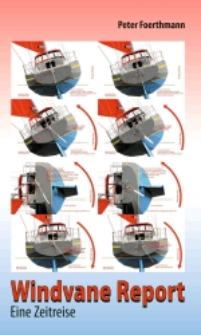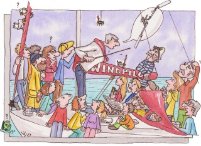SHANE FREEMAN PRACTISING THE JSD DROGE IN THE SOUTH PACIFIC
A multi-facted, and complex discussion, where theory and praxis can vary a lot.
Obviously, in an event like the GGR, no crew is available to support the single handed skipper other than his „transom ornament“, i.e. his windvane steering slave. Deploying and using a JSD in these circumstances will require either the skipper or the windvane – as APs were not allowed – at the helm until the JSD is doing its duty: Reducing speed and keeping the vessel’s stern to wind and sea.
There will hardly be time to lift a pendulum rudder out of the water, before setting the JSD, unless the skipper can work miracles or have 4 arms and hands. And once the JSD is in action, sideways lifting of the pendulum rudder will be difficult due to the huge lever of 160cm or more. If it can be lifted out, it will likely foul the JSD bridle. Lifting up the pendulum rudder in the aft direction – like on an Aries or Monitor – can cause different problems with large forces that can snap the overload protection devices. Finally, a pendulum rudder sticking up in the air at the stern is a perfect place for the JSD bridle to get caught when slack develops and/or the boat veers momentarily off course. In summary, none of this ideal.
A better alternative might be:
Using the windvane until JSD is in operation. Shane has demonstrated how to set up the rig and sails to ensure the horsepower is all at the front – just a tiny storm jib sheeted hard amidships. Once set up, the windvane will continue to work well with this setup. If the JSD is well sized for the boat, the vessel will be inherently stable and will not require aggressive steering action. Perfect conditions for the windvane and it will work to help the JSD.

credit: Susanne Huber Curphy
A small anecdote: Unfortunately Clark Stede didn’t recognise the importance of perfectly aligning the pendulum rudder with its shaft. The result was that the unit didn’t work well for him. He never bothered to read the manual, or enquire with the manufacturer. So he ended up changing to a Monitor. I found his Windpilot Pacific nailed to Hans Bernwall’s showroom wall in Richmond California some years later. A prestigious trophy. Not my best day, but I had a great dinner on Hans´ terrace overlooking Sausalito Bay.
Disengaging a wind vane at any moment is easy, just release the clutch on the wheel drum or unhook the chain from the tiller, and vane will be powerless and follow the vessel like a dog on the leash. Just need to keep the JSD ropes clear of the unit on the stern and it will always be ready to go back to work in a second. On a Windpilot there will be no sideways limit for the pendulum – unlike on the Aries or Monitor – so there is very little potential for damage.
We have described the differences between sailors in racing or cruising mode perfectly and there is nothing more to add.
The comparison between LLR and GGR tells the whole story. I like the fact that a French Contessa 32 made her way round in just a few days longer than Jean Luc without any sensational Yellow or Red Code Press release. A joy to see for the cruising soul.
We have referred to OVERLOAD PROTECTION on windvanes and added the link to my homework essay on this subject. Perhaps I should add the following link, which expands further on this subject:
https://windpilot.com/blog/en/golden-globe-race/windvane-striptease-2/
Its seems to me, storm tactics, like the use of the JSD, are similarly important as the discussion about sideways overload protection on servo pendulum systems to improve safety for the sailors at sea. In tough conditions, all links in the chain must work together.
Disregarding the stressful 290 days and some very particular human experiences, the GGR event has provided me with some useful lessons. In the end, I am grateful for these.
Abhilash’s, Hans‘ and John’s comments about lifting up of the servo oar are perfectly practical. However, they require some care and good technique. A general comment about this will never be found in a manual, as this might result in a situation where yachtsmen try lifting up the pendulum rudder with winches or other inappropriate means, which would likely result in damage.
And there we have the difference between theory and practice.
Peter Foerthmann





























